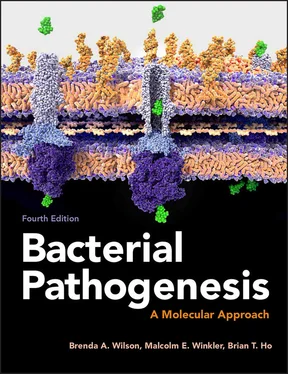Earlier in the 20th century, before the advent of centralized food processing and distribution, foodborne disease outbreaks tended to be confined to church socials, family gatherings, or business-sponsored employee picnics ( Box 1-2). As the food industry became more centralized, however, a different pattern of foodborne disease emerged: the multistate (or even multicountry) outbreak of foodborne disease derived from a single source. The nature of foodborne outbreaks has changed considerably from the days of the church social outbreaks, and the effect on the public has been dramatic. In the case of the E. coli O157:H7 outbreak described above, a single processing plant was the source. Contaminated radish sprouts caused another outbreak of E. coli O157:H7 in Japanese schoolchildren. The seeds used by the Japanese sprouting companies came from a single source in the northwestern United States, where the initial contamination event probably occurred. In 2006, E. coli O157:H7-contaminated spinach grown in California and used by consumers in spinach salads was spread throughout the United States. In 2009, E. coli O157:H7 showed up yet again, this time in refrigerated cookie dough sold throughout the United States.
Box 1-2.
Bioterrorism Hits Oregon Salad Bars
In 1984, a large outbreak of salmonellosis involving at least 750 people occurred in The Dalles, the county seat of Wasco County in Oregon. At the time, a religious commune was at odds with local residents over land-use restrictions placed on the commune in an attempt by the townspeople to eliminate it. Members of the commune felt that the outcome of an upcoming election was critical to their future ability to grow. In an apparent attempt to disrupt the election, commune members planned to cause an outbreak of salmonellosis that would keep people home from the polls. The outbreak was a trial run to determine the best way to create the most havoc. At least 10 restaurants were involved, with the salad bar being the main site of intentional contamination. Contamination attempts were also made at local grocery stores, but the restaurant salad bars were the most effective source of disease. Unfortunately for commune members, their trial run was too successful and attracted the attention of the Public Health Department and the police.
Even so, it took nearly a year to trace the epidemic source and to suspect intentional contamination. Such events are fortunately quite rare, so intentional contamination was not even considered at first as a possible explanation for the outbreak. Careful questioning of the victims led investigators to deduce that salad bars had been the main source of the outbreak. Further interrogation of commune members by police and FBI agents revealed that the commune members had been the perpetrators of the outbreak. The commune had its own laboratory, where the strain of Salmonella enterica serovar Typhimurium was grown and prepared for inoculation of the salad bars. Commune members had apparently gotten the strain by ordering it from the American Type Culture Collection (ATCC), a widely respected repository of bacterial strains that distributes strains to scientific laboratories for a modest fee. Nearly 2 years after the outbreak, two commune members were sentenced to 1 to 2 years in prison for conspiring to tamper with consumer products. An earlier episode of product tampering involving introduction of cyanide into Tylenol capsules had been responsible for a rash of antitampering legislation. These antitampering laws were used to prosecute the commune members. As a precaution against misuse of its cultures, the ATCC has tightened restrictions on obtaining certain bacterial stocks.
Source:
Török TJ, Tauxe RV, Wise RP, Livengood JR, Sokolow R, Mauvais S, Birkness KA, Skeels MR, Horan JM, Foster LR. 1997. A large community outbreak of salmonellosis caused by intentional contamination of restaurant salad bars. JAMA 278:389–395. [PubMed] [CrossRef]
Similar to foodborne diseases, outbreaks of waterborne disease continue to occur, despite advances in water management and sanitation; however, they tend to be more localized in nature. Most of the waterborne outbreaks that have made the news lately were caused by aging pipes and water treatment plants or by mammal and bird fecal material in water reservoirs. Over half of all waterborne illnesses in the United States in recent years have been associated with contamination of drinking water with Legionella, a Gram-negative bacterium commonly found in soil and aquatic environments. Other microbes associated with waterborne outbreaks are E. coli and Campylobacter bacteria and the parasites Giardia and Cryptosporidium. The media picked up on this contamination problem, as was seen on a cover of Time magazine (August 3, 1998) showing E. coli cascading out of a kitchen tap. The event that stimulated this particular media response was an outbreak that occurred among 61 residents of Alpine, Wyoming (total population 470), who drank tap water on one particular weekend. Wild animals had probably contaminated the spring that was the source of the town’s tap water.
An often-overlooked aspect of waterborne infectious microorganisms is that contaminated water can also produce a contaminated food product if that water is used to wash the food. In most cases, water used to wash dirt off fruits and vegetables prior to shipping is not tap water quality and is instead what is referred to as “gray water”: water processed to remove the worst contamination but not microbiologically sterile. In some foodborne outbreaks, the contamination may actually have come from water used to wash the food. At first, vegetarians felt safe because foodborne diseases were so often spread by meat. But nowadays most people concerned with ensuring food safety consider any foods that are consumed raw, such as fruits and vegetables, a potentially more serious threat to public health. If meat or other food is properly cooked, the contamination problem is solved, but even careful washing is not always sufficient to render contaminated raw fruits or vegetables safe.
Modern Medicine as a Source of New Diseases
Modern medicine has made impressive breakthroughs in therapies for many human diseases. Surgeons now routinely transplant new organs into patients whose own organs are failing. Cancer chemotherapy is becoming more and more effective. This progress has come at a cost, however. Transplant patients and patients receiving cancer chemotherapy have suppressed immune systems due to the medications they are taking. This immunosuppression is temporary in the case of cancer patients and ends when the chemotherapy is finished, but transplant patients take their immunosuppressive therapy for life. Also, there are a large number of individuals suffering from infectious diseases, such as human immunodeficiency virus (HIV), that are immunosuppressive. Not surprisingly, these immunocompromised patients can become infected with bacteria never before suspected to be able to cause human disease.
Other bacteria cause disease not because the patient is immunocompromised, but because a physical barrier against bacterial invasion is bypassed. For example, accidental perforation of the colon during surgery releases gut bacteria into tissue and blood. Patients with certain types of respiratory infections may have ventilator tubes inserted to keep their airways open, which can allow bacteria to bypass some of the defenses of the respiratory tract to directly enter the lungs. Likewise, catheters enable bacteria to bypass the normal cleansing flow of urine to gain access to the bladder.
Opportunistic pathogens that normally do not cause disease are able to cause disease because some defense of the body that normally keeps them at bay has been breached, giving them the opportunity to cause infection. For an interesting example of an opportunist from an unexpected source, see Box 1-3. The term “opportunist” makes such bacteria seem somehow less dangerous than “real” disease-causing bacteria. Do not be fooled by the seemingly innocuous nature of the opportunists! In most developed countries, a person is far more likely to die from an opportunistic infection than from the epidemic diseases that serve as the public’s mental image of infectious diseases.
Читать дальше












